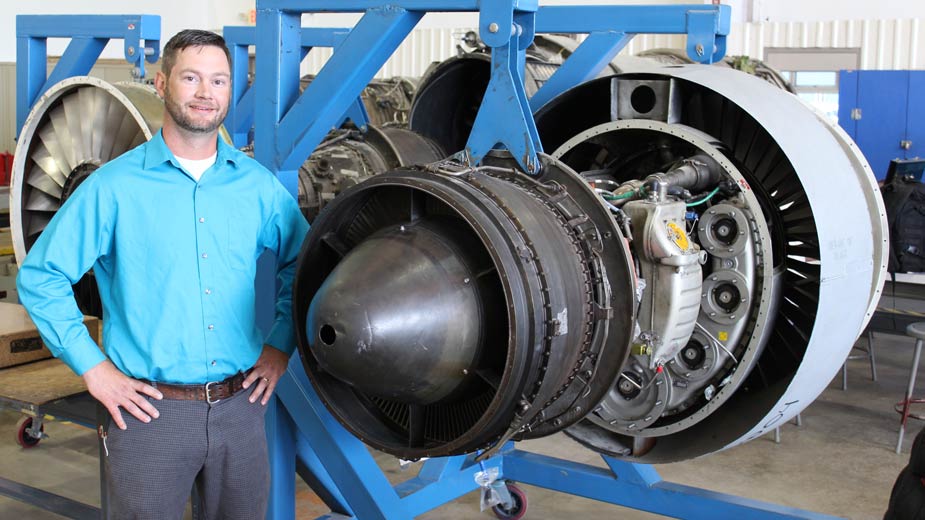High-Flying Careers Take Off at PIA
VIENNA, Ohio — Not far from the tarmac at Youngstown Warren Regional Airport, Greg Chabek applies the final touches on a refurbished engine that he and his classmates have spent the past few weeks working on.
As he inspects gaskets and connections within the plane engine, the rest of his group looks over blueprints.
“We’re looking all of it over right now,” Chabek says, parts in hand as he walks back to his group. “This is our first time working on a running engine.”
In their third semester at the Vienna campus of the Pittsburgh Institute of Aeronautics, Chabek’s group is rebuilding a functional engine for the first time. Last semester, they tinkered with one that doesn’t run, but this time it’s the real deal. If all goes right, it’ll be running in a few days.
After this, the students at Pittsburgh Institute of Aeronautics, or PIA, will move on to the airframe segment of the program, learning to repair and fabricate plane bodies.
At the conclusion of the four-semester program that runs 16 months – it begins with a general aviation course that covers physics, math, blueprint reading and a history course – students graduate with the airframe and powerplant, known in the industry as A&P, certification from the Federal Aviation Administration.
With that license, graduates can work just about anywhere in the aviation industry. Many go on to be mechanics, but others have gone on to work in air traffic control or even as pilots, says campus director Joe DeRamo. This certification, he says, is their foot in the door.
And the room beyond that door is huge. By 2024, it’s estimated there will be more than 30,000 job openings for aircraft mechanics. By 2035, aircraft manufacturer Boeing projects 118,000 aircraft technicians will be needed in North America. These jobs pay well, too, with an early career salary of $52,900, as calculated by Forbes, and a median salary of $60,270 per the Bureau of Labor Statistics.
“The biggest problem [our students] have is debating which job offer to take. They’re going to have multiple job offers,” DeRamo says. “One student who graduated last semester had five on the table. They were putting some pressure on him because they really need mechanics.”
 Joe DeRamo, Vienna campus director, says students have graduated with as many as five job offers in recent years.
Joe DeRamo, Vienna campus director, says students have graduated with as many as five job offers in recent years.
Many students go to work in the areas near major airports, such as the Akron-Canton area, Cleveland or Atlanta, although some stay nearby to work for Winner Aviation, which operates out of the Youngstown-Warren Regional Airport and has a hangar not near the one PIA students use.
“Then there are a lot of facilities in Ohio that work in cargo processing for places like Amazon, Fedex and UPS,” DeRamo continues. “A lot of students can go work there because they have so many aircraft and they need to be kept running.”
The Vienna campus has a 96% placement rate for graduates, a figure similar to the other PIA satellite campuses in Myrtle Beach, S.C., and Hagerstown, Md. The main campus at the Pittsburgh International Airport, which has an associate’s degree program in addition to the A&P license curriculum, has an 85% placement rate.
For its efforts, Forbes has ranked the Pittsburgh Institute of Aeronautics as the No. 11 trade school in the country.
While some students arrive at PIA to avail themselves of the opportunities in the aviation industry, many more arrive with a simple love for aircraft. Among them is John Ray, who enrolled after returning from serving with the Army. It was there that he was first exposed to working on aircraft.
“I have that aviation background. But for the civilian side, you need your airframe and power- plant license, regardless of experience,” he says as he tightens bolts on a donated Beechcraft airplane the students work on.
“I’m glad I did because I’ve learned a lot more doing this, instead of just basing it off my experience in the military. [Pay] doesn’t matter. I love all aircraft, so anything is fine with me.”
Then there are those who arrive with little knowledge of aircraft – students also work on helicopters and drones – and for them, what’s appealing is two things, DeRamo explains: troubleshooting and working with their hands.
“We get students who say they’ve never changed their own oil, who aren’t gearheads,” he says. “If you like to work with your hands and have some troubleshooting and problem-solving skills, that’s the student we’re after. We’ll teach them what they need to know about engines, aircraft and physics.”
To help students hone their troubleshooting skills, boards of instrument clusters are set up throughout the hangar, tucked between planes and engines. As parts of assignments, students have to navigate the panels and switches to figure out which part in particular is causing the problem the teacher created.
“A lot of the boards are taken from actual cockpits. So they’re working on troubleshooting and fixing them in the hangar,” says admissions representative Lori Fine. “All of our instructors have worked in the field, so they’re able to bring that experience to [students’] education, too.”
The Vienna campus has six instructors, five full-time, all of whom have worked in the aviation business as professionals. The ability to relay that knowledge of how things work in real-world jobs to students has prepared them well, teachers say.
“There’s a lot of research. Everything is documented. Our procedures are written by engineers, so they have to learn to read technical manuals and pull information from them,” says instructor William Ogle. “Being able to look up that information on a particular make or model is an important skill in this area.”
Bookcases filled with technical manuals are scattered throughout the hangar, each hundreds of pages long and each contains crucial information about specific plane models.
Some manufacturers go as far as dictating whether a Sharpie or other brand of permanent marker should be used when marking dents on sheet metal. Even when it comes to the hands-on part of the curriculum, books are still involved.
“They can do everything to FAA standards and have a reference to do it step by step,” says instructor Lee Grable. “One of the best things with this industry is that it’s rewarding. There’s immediate gratification. You disassemble, re-assemble and you see it operating.”
Mention “mechanic” and “trade school” in the same sentence and people often think of learning to work on cars, trucks and sometimes even tractors. There is ample overlap, says Ogle, who worked as an auto mechanic before enrolling at PIA when he was 30. Whether cars or planes, the electrical, mechanical and hydraulic systems work the same.
The biggest difference is how closely everything has to be watched.
“We’re very particular with closer tolerances,” Ogle says. “There are very accurate measurements. We can’t pull over on the nearest cloud. It has to be right. We check, double check and recheck. There are a lot of redundant systems and fail-safes.”
Every fastener on an engine, for example, is hooked to a safety wire anchored elsewhere on the engine. The tensions in the wire hold both ends in place.
For many students, DeRamo says, that attention to detail – and the responsibility that comes with it – is what draws them in.
“There’s a cool factor, isn’t there?” he asks. “It’s cool to be able to say, ‘I worked on an aircraft and was the last person to sign off on its functionality before it took off.’ That student has that kind of responsibility when they leave here.”
Pictured at top: After a few years in the aviation industry, Lee Grable has returned to PIA as a teacher.
Copyright 2024 The Business Journal, Youngstown, Ohio.



